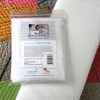Silk
Silk is a fine, strong natural fiber produced from a domesticated silkworm's cocoon. Roughly 1,000 yards of fiber can be reeled off a single cocoon. The fiber is then used to make thread and woven into fabric. Weaving silk began in China and there is evidence of silk garments from the 4th and 3rd centuries BCE. Silk is used in garments for its wonderful drape and movement. It is also highly absorbent and dries fast. There are many types of silk fabric, each are differentiated by the thread preparation and weaving technique used. Natural silk is the most hypoallergenic fabric of all fabric and does not easily create static electricity and doesn't lose its sheen over time. Silk is used for a wide variety of materials from Tulle to Damask, raw silk to silk chiffon and velvet.
Silk Dupioni is most often used by quilters and is characterized with a single thread warp and two or more on the weft with prominent slubs or irregularities. Dupioni is an Italian silk generally woven with two different colors, yeilding a glimmering and iridescent property. The slubs and color of Dupioni will give the quilter options on how to use the fabric as it will look different on each grain. Silk Shantung, a Chinese silk, is also used by quilters. Shantung is finer, has hardly any slubs and is made with one color. Due to the value of silk, these fabrics are often imitated. To test fabric to find genuine silk, burn a few fibers and it should smell like burnt hair or burn the edge of the fabric, the flame will be invisible and it will stop burning as soon as the flame is blown out. Silk is often used for applique, piecing or as silk batting. Silk ribbon is also used for quilt embellishments and applique.
Benefits of Silk
- Silk is lustrous with vibrant colors.
- Silk Dupioni will look different based on the irredescence and colors used when the silk was woven.
- Silk Dupioni or Shantung have texture which adds interest and texture.
- Silk has insulating properties.
- Silk has a wonderful drape for use in garments.
- Silk batting is known for it's good hand quilting properties.
Tools and Supplies for Silk
- Silk pins (super fine, thin pins)
- Ultra-lightweight fusible interlining to prevent raveling or puckering
What I Wish I Knew When I Started using Silk
SILK will add luster to applique projects. The lightweight fusible will stabilize the silk and make it easier for piecing.










